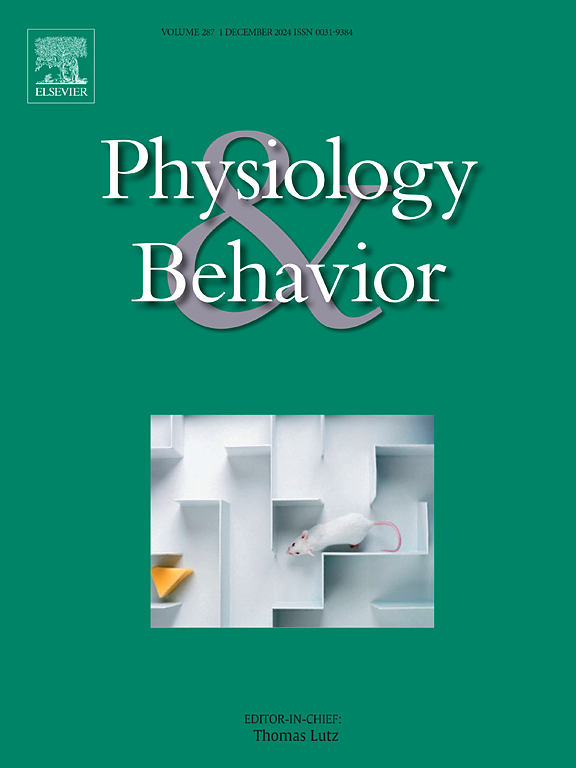SENP3 knockdown improves motor and cognitive impairments in the intranasal MPTP rodent model of Parkinson's disease
IF 2.4
3区 医学
Q2 BEHAVIORAL SCIENCES
引用次数: 0
Abstract
Several mechanisms underlying Parkinson's disease (PD) remain unclear, and effective treatments are still lacking. The conjugation of the small ubiquitin-like modifier (SUMO), known as SUMOylation, to key proteins in PD has shown potential beneficial effects. Considering that this process is reversed by SUMO-specific proteases (SENPs), this study addressed the effects of increased SUMO-2/3 conjugation, mediated by SENP3 knockdown, in the intranasal 1-methyl-4-phenyl-1,2,3,6-tetrahydropyridine (MPTP) rodent model of PD. Two weeks after infusion of the shRNA-containing lentiviral vector into the dorsolateral striatum and one week following intranasal MPTP administration, male Wistar rats were evaluated using cognitive and motor behavioural tests. Infection efficiency was confirmed by detecting GFP expression in the dorsolateral striatum. SENP3 knockdown, verified by Western blotting, resulted in increased SUMO-2/3 conjugation. MPTP-administered rats displayed impairments in both recognition and spatial memories, while SENP3 knockdown prevented these deficits. Rats exposed to MPTP also exhibited motor dysfunction, which was ameliorated by SENP3 knockdown. These findings underscore the involvement of SUMO-2/3 conjugation in PD and its potential as a novel therapeutic target to counteract cognitive and motor impairments induced by neurodegeneration.
敲除 SENP3 可改善鼻内 MPTP 帕金森病啮齿动物模型的运动和认知障碍。
帕金森病(Parkinson's disease,PD)的几种发病机制尚不清楚,也缺乏有效的治疗方法。在帕金森病中,小泛素样修饰物(SUMO)与关键蛋白的共轭(称为 SUMOylation)已显示出潜在的有益作用。考虑到这一过程会被SUMO特异性蛋白酶(SENPs)逆转,本研究探讨了在鼻内注射1-甲基-4-苯基-1,2,3,6-四氢吡啶(MPTP)的啮齿动物帕金森病模型中,由SENP3敲除介导的SUMO-2/3共轭作用增加所产生的影响。将含有 shRNA 的慢病毒载体注入背外侧纹状体两周后,以及鼻内注射 MPTP 一周后,用认知和运动行为测试对雄性 Wistar 大鼠进行评估。通过检测背外侧纹状体中的 GFP 表达来确认感染效率。通过 Western 印迹验证,SENP3 基因敲除导致 SUMO-2/3 连接增加。服用 MPTP 的大鼠在识别和空间记忆方面都出现了障碍,而 SENP3 的敲除则防止了这些障碍的出现。暴露于 MPTP 的大鼠还表现出运动功能障碍,而 SENP3 基因敲除可改善这种障碍。这些发现强调了SUMO-2/3共轭在帕金森病中的参与及其作为一种新型治疗靶点以对抗神经变性引起的认知和运动障碍的潜力。
本文章由计算机程序翻译,如有差异,请以英文原文为准。
求助全文
约1分钟内获得全文
求助全文
来源期刊

Physiology & Behavior
医学-行为科学
CiteScore
5.70
自引率
3.40%
发文量
274
审稿时长
47 days
期刊介绍:
Physiology & Behavior is aimed at the causal physiological mechanisms of behavior and its modulation by environmental factors. The journal invites original reports in the broad area of behavioral and cognitive neuroscience, in which at least one variable is physiological and the primary emphasis and theoretical context are behavioral. The range of subjects includes behavioral neuroendocrinology, psychoneuroimmunology, learning and memory, ingestion, social behavior, and studies related to the mechanisms of psychopathology. Contemporary reviews and theoretical articles are welcomed and the Editors invite such proposals from interested authors.
 求助内容:
求助内容: 应助结果提醒方式:
应助结果提醒方式:


